Sparkplugs
The spark plug is quite simple in theory. It ignites the air-fuel mixture in the engine cylinder by generating sparks between the center electrode and earth electrode. The electricity must be at a very high voltage in order to travel across the gap and create a good spark. Voltage at the spark plug can be anywhere from 40,000 to 100,000 volts. And petrol engine without a spark plug is useless. There is a lot of different spark plugs, and they'll all do the job but the more you pay, the better the plug. All spark plugs share the same basic design and construction though.
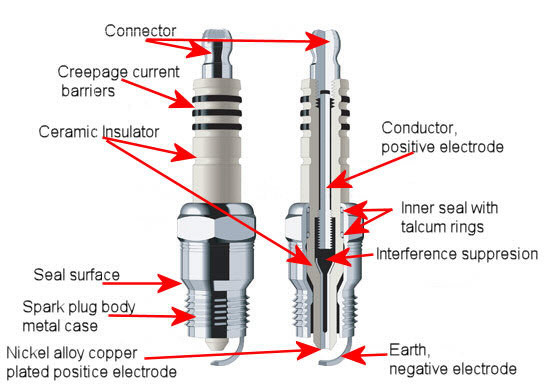
The connector is designed as an SAE connection or a 4 mm thread. There is where you plug ignition cable coming from high voltage coil, or a rod coil . High voltage coupled here must be transported to the other end of the spark plug.
The high voltage coil is the device that generates the high voltages required to create a spark. It is a simple device - essentially a high-voltage transformer made up of two coils of wire. One coil of wire is called the primary coil. Wrapped around it is the secondary coil. The secondary coil normally has hundreds of times more turns of wire than the primary coil.
Current flows from the battery through the primary winding of the coil. The primary coil's current can be suddenly disrupted by the breaker points, or by a solid-state device in an electronic ignition.
If you think the coil looks like an electromagnet, you're right - but it is also an inductor. The key to the coil's operation is what happens when the circuit is suddenly broken by the points.
The magnetic field of the primary coil collapses rapidly. The secondary coil is engulfed by a powerful and changing magnetic field. This field induces a current in the coils - a very high-voltage current (up to 100,000 volts) because of the number of coils in the secondary winding. The secondary coil feeds this voltage to the distributor via a very well-insulated, high-voltage wire and special protected connector.
High voltage coil on Formula 1 car is not the same as on road cars, where there is one coil for 4 sparkplugs, or at least one coil for few sparkplugs. In Formula 1, one high voltage coil serves only one sparkplug. The four-pronged carbon fibre cased unit are press fit atop each spark plug, and connected with and trough CAN-bus electronic interface to ECU unit.
The spark plug must have an insulated passageway for this high voltage to travel down to the electrode, where it can jump the gap and, from there, be conducted into the engine block and grounded. The spark plug also has to withstand the extreme heat and pressure inside the cylinder, and must be designed so that deposits from fuel additives do not build up on the plug. Spark plugs use a ceramic insulator to isolate the high voltage from electrode, ensuring that the spark happens only at the tip of the electrode and not anywhere else on the plug. Ceramic does double-duty by helping to burn off fuel deposits. Ceramic is a fairly poor heat conductor, so the material gets quite hot during operation. This heat helps to burn off deposits from the electrode. The wave-shaped creepage current barriers on the outside of the insulator prevent the leakage of voltage to the vehicle mass. In doing so, they extend the path to be travelled and increase the electrical resistance.
The inner seals create a gas-tight connection between insulator and metal housing. For this purpose, a talcum ring is enclosed between two additional seal rings. During the production of the spark plug it breaks down, ensuring an optimal seal.
 Spark-plug sizes vary, but a basic one used in a current production car is about 85 millimeters long, with a maximum diameter of roughly 15 to 20 millimeters. The bottom third of a plug's length is covered by a sleeve of steel threads, there's a metal stud on the top, and the white ceramic insulator. If you cut a plug in half down the length, you'll see an internal metal rod that extends from the top to a point near the bottom of the steel threads. Sometime this rod is separated by interference suppressor. In order to ensure the electromagnetic compatibility (EMC) and thus the fault-free operation of the onboard electronics, a glass melt is used inside the spark plug as interference suppression. From there high voltage pass to the middle electrode. This electrode on a standard spark plug is comprised mostly of a nickel alloy and copper core which improves the heat dissipation. From the end of this electrode the spark must jump over to the earth electrode.
Spark-plug sizes vary, but a basic one used in a current production car is about 85 millimeters long, with a maximum diameter of roughly 15 to 20 millimeters. The bottom third of a plug's length is covered by a sleeve of steel threads, there's a metal stud on the top, and the white ceramic insulator. If you cut a plug in half down the length, you'll see an internal metal rod that extends from the top to a point near the bottom of the steel threads. Sometime this rod is separated by interference suppressor. In order to ensure the electromagnetic compatibility (EMC) and thus the fault-free operation of the onboard electronics, a glass melt is used inside the spark plug as interference suppression. From there high voltage pass to the middle electrode. This electrode on a standard spark plug is comprised mostly of a nickel alloy and copper core which improves the heat dissipation. From the end of this electrode the spark must jump over to the earth electrode.
A small piece of metal that looks like a hook extends from the bottom of the threads and comes close to-but doesn't touch-the lower end of the internal metal rod. That space is called the "gap," and it's across this area that the sparks occur to ignite the fuel-and-air mixture in the cylinder. By the way, the metal surfaces on either side of the gap are "electrodes," and the hook is commonly referred to as the "ground electrode". So, spark induced by high voltage coil jump from center rod to ground electrode.
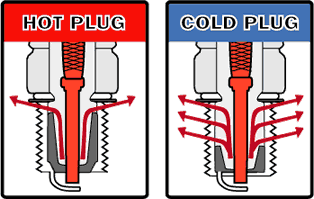 Something that is often overlooked in spark plugs is their heat rating or heat range. The term "heat range" refers to the relative temperature of the tip of the spark plug when its working. The hot and cold classifications often cause confusion because a 'hot' spark plug is normally used in a 'cold' (low horsepower) engine and vice versa. The term actually refers to the thermal characteristics of the plug itself, specifically its ability to dissipate heat into the cooling system. The difference between a "hot" and a "cold" spark plug is in the shape of the ceramic tip. The carmaker selects the right temperature plug for each car. A cold plug can get rid of heat very quickly and should be used in engines that run hot and lean. A hot plug takes longer to cool down and should be used in lower compression engines where heat needs to be retained to prevent combustion byproduct buildup. Some cars with high-performance engines naturally generate more heat, so they need colder plugs. If the spark plug gets too hot, it could ignite the fuel before the spark fires; so it is important to stick with the right type of plug for your car.
Something that is often overlooked in spark plugs is their heat rating or heat range. The term "heat range" refers to the relative temperature of the tip of the spark plug when its working. The hot and cold classifications often cause confusion because a 'hot' spark plug is normally used in a 'cold' (low horsepower) engine and vice versa. The term actually refers to the thermal characteristics of the plug itself, specifically its ability to dissipate heat into the cooling system. The difference between a "hot" and a "cold" spark plug is in the shape of the ceramic tip. The carmaker selects the right temperature plug for each car. A cold plug can get rid of heat very quickly and should be used in engines that run hot and lean. A hot plug takes longer to cool down and should be used in lower compression engines where heat needs to be retained to prevent combustion byproduct buildup. Some cars with high-performance engines naturally generate more heat, so they need colder plugs. If the spark plug gets too hot, it could ignite the fuel before the spark fires; so it is important to stick with the right type of plug for your car.
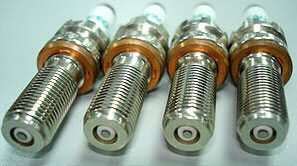 Modern Formula 1 engine is an incredible thing, with a spec sheet that makes car lover like me queasy. The basics are incredible. From just 2.4 liters and 8 cylinders-without horsepower-enhancing turbocharging or supercharging-an F1 engine makes about 800 horsepower. It does this by revving to an incredible 18,000 rpm, or more than double what a rev-happy Honda S2000 engine spins to. After 2014 rules change, from 1.6 liters V6 engine is again delivering over 800 horsepower on 15.000 RPM's, with help of ERS.
Modern Formula 1 engine is an incredible thing, with a spec sheet that makes car lover like me queasy. The basics are incredible. From just 2.4 liters and 8 cylinders-without horsepower-enhancing turbocharging or supercharging-an F1 engine makes about 800 horsepower. It does this by revving to an incredible 18,000 rpm, or more than double what a rev-happy Honda S2000 engine spins to. After 2014 rules change, from 1.6 liters V6 engine is again delivering over 800 horsepower on 15.000 RPM's, with help of ERS.
To keep the pistons and connecting rods from flying apart at those revolutions, an F1 piston travels only about 40 millimeters. The bore is roughly 90 millimeters (called supersquare bore).
It's impossible to acquire the specifics of current Formula 1 engines because those are well-guarded secrets within each team.
F1 fans are curious beings, though, and I wondered what kind of interesting technical details are housed in the usually not-so-glamorous spark plug.
Apparently, F1 spark plugs are not all that secret because Federal-Mogul's global director of ignition technology, Richard Keller, talk openly about this item and research. Federal-Mogul is an owner of Champion.
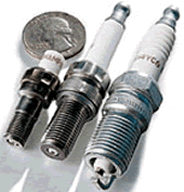 |
Sparkplugs, left to right- F1, GP bike, Ford Focus |
Champion's basic Formula 1 plug that was used in the 1990s was similar in length to the normal one described above, but half the diameter. Then in 1999, one of the teams told McMurray that for the amount of space the spark plug inhabited, it was the heaviest part on the car (that plug weighed only 25.9 grams) because it was located very high on engine. Unless Champion could reduce the weight of the plug by 20 percent every year until the team told them to stop, Champion was going to be out.
The plug Champion produced in response, is smaller than your pinky. It's only 35 millimeters long, and the diameter of its threads is 7.6 millimeters, or roughly half the diameter of a conventional plug. It also requires a special tool for installation so that the spark-plug hole in the cylinder head can be made as small as possible. Empty space in an F1 combustion chamber is a precious because any space taken by the spark plug leaves less room for the valves, and as we all know, the larger the valves, the greater the airflow, and the greater the potential power output. The plug weighs 10.7 grams.
 Besides its tiny size, another interesting feature of the F1 plug is that there's no protruding hook on the bottom. That's because simply there is no room for one. A normal ground J shaped electrode doesn't have a chance of surviving in an F1 motor, It would get crushed by the piston or simply shaken loose by the intense vibration. When an F1 piston is at the top of its stroke, it just about touches the cylinder head. The combustion-chamber volume is mostly made up of the recessed parts in the piston tops that are there to provide room for the valves. Without that hook, the ground electrode is simply the bottom edge of the threads. This design is known as a surface-gap spark plug. Surface-gap spark plug is a spark plug designed to produce sparks along the isolator surface at the ignition end. This spark plug type is also classified as semi-superficial discharge type and superficial discharge type. This spark plug has a smaller heat exposed isolator, therefore, it gets dirty easily. To overcome dirt, a capacitor discharge system is used which reaches rapidly the required voltage to produce the sparks. It is used in engines of high performance like the engines of Formula 1.
Besides its tiny size, another interesting feature of the F1 plug is that there's no protruding hook on the bottom. That's because simply there is no room for one. A normal ground J shaped electrode doesn't have a chance of surviving in an F1 motor, It would get crushed by the piston or simply shaken loose by the intense vibration. When an F1 piston is at the top of its stroke, it just about touches the cylinder head. The combustion-chamber volume is mostly made up of the recessed parts in the piston tops that are there to provide room for the valves. Without that hook, the ground electrode is simply the bottom edge of the threads. This design is known as a surface-gap spark plug. Surface-gap spark plug is a spark plug designed to produce sparks along the isolator surface at the ignition end. This spark plug type is also classified as semi-superficial discharge type and superficial discharge type. This spark plug has a smaller heat exposed isolator, therefore, it gets dirty easily. To overcome dirt, a capacitor discharge system is used which reaches rapidly the required voltage to produce the sparks. It is used in engines of high performance like the engines of Formula 1.
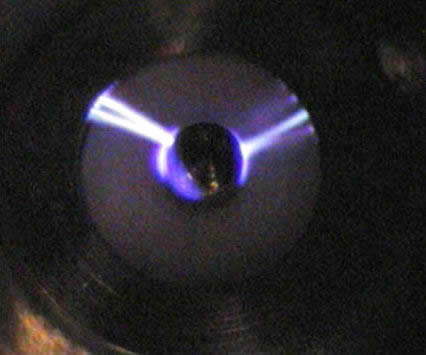 |
Surface-gap spark plug is a spark plug designed to produce sparks along the isolator surface at the ignition end. More 50.000 volts…… firing at 20,000 RPM |
To get an idea of the precision of the components of an F1 engine, when Champion builds its F1 spark plugs, the length varies minutely from plug to plug. This is known as manufacturing tolerance; for the F1 plugs, the difference from the longest to the shortest plug is only 0.05milimeters, or about the same as the thickness of the hair. If a spark plug is on the long side, the piston might hit it, so teams machine a divot in the piston or shim the spark plugs with washers.
Over the course of a year, Champion produces about 10,000 of these special units, and they're not cheap. Whereas you or I might pay two bucks for a spark plug, an F1 team spend between $35 and $50 each, or as much as $500 per engine.
We all know the old racing saying: "Speed costs money. How fast do you want to go?"
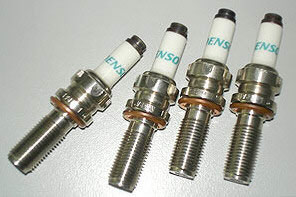 |
Denso surface discharge spark plugs used in F1 engines |
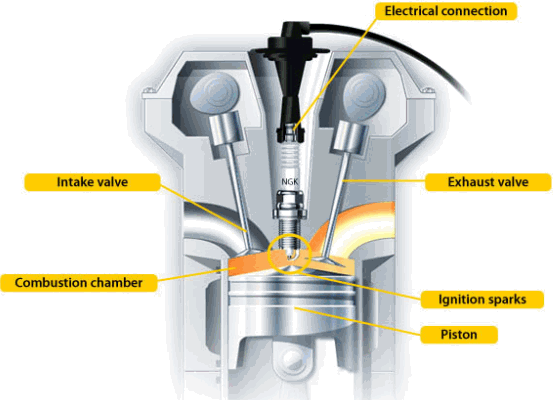
Main suppliers for F1 teams are US based Champion, Italian Magneti Mareli and Japan based NGK and Denso.
NGK Spark Plugs first took up the challenge of Formula One together with Honda in 1964, and achieved their first victory the following year.
At the start of the second golden age of Honda Formula One, the performance of NGK spark plugs in Honda engines was recognized, and soon these plugs were fitted in many other Formula One engines. In 1998, a car with a Mercedes engine fitted with NGK spark plugs took NGK to its 100th victory in Formula One, and in 2007, cars fitted with NGK spark plugs achieved wins in all 17 races, stretching the total to 200 wins.
In 2011, NGK supply spark plugs to 2 engine manufacturers, Mercedes and Ferrari. NGK spark plugs are fitted in the engines of 12 of these manufacturers cars belonging to a total of 6 teams
5.9 Ignition systems :
5.9.1 Ignition is only permitted by means of a single ignition coil and single spark plug per cylinder. The use of plasma, laser or other high frequency ignition techniques is forbidden.
5.9.2 Only conventional spark plugs that function by high tension electrical discharge across an exposed gap are permitted. Spark plugs are not subject to the materials restrictions described in Articles 5.14 and 5.15.
Back to the top of the page






